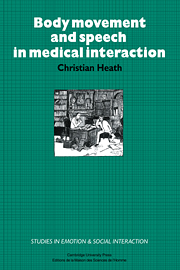Book contents
- Frontmatter
- Contents
- Preface
- The transcription system
- 1 Video analysis: interactional coordination in movement and speech
- 2 The display of recipiency and the beginning of the consultation
- 3 Maintaining involvement in the consultation
- 4 Forms of participation
- 5 The physical examination
- 6 Taking leave of the doctor
- 7 Postscript: the use of medical records and computers during the consultation
- Notes
- References
- Index
2 - The display of recipiency and the beginning of the consultation
Published online by Cambridge University Press: 19 January 2010
- Frontmatter
- Contents
- Preface
- The transcription system
- 1 Video analysis: interactional coordination in movement and speech
- 2 The display of recipiency and the beginning of the consultation
- 3 Maintaining involvement in the consultation
- 4 Forms of participation
- 5 The physical examination
- 6 Taking leave of the doctor
- 7 Postscript: the use of medical records and computers during the consultation
- Notes
- References
- Index
Summary
In the external demeanour nothing will be found so effectually to attract attention, and to detain it, as the direction of the eyes. It is well known that the eyes can influence persons at a distance; and that they can select from a multitude a single individual, and turn their looks on him alone, though many lie in the same direction. The whole person seems to be in some measure affected by this influence of another's eyes, but the eyes themselves feel it with the most lively sensibility.
G. Austin 1806, p. 101In the beginning of the consultation the participants move from the preliminaries to the business at hand, the reason for the patient's visit. Greetings are exchanged, identities checked, the patient establishes an appropriate spatial and physical orientation, and the doctor sorts out equipment and documentation, not infrequently reading the medical record cards. These preliminaries entail a variety of concerns: a constant shifting of attention in which the participants are more or less aware of each other's actions and activities; a fragmentation of involvement, and necessarily so. In contrast, movement into the business of the consultation establishes a mutual focus of involvement, a stretch of continuous activity that concerns both participants and requires their coordination and joint attention.
Looking at one another plays a significant part in the process of establishing a common focus of activity and involvement, not simply as a means of monitoring each other's concerns and behaviour, but actually in initiating action and activity.
- Type
- Chapter
- Information
- Body Movement and Speech in Medical Interaction , pp. 25 - 48Publisher: Cambridge University PressPrint publication year: 1986
- 1
- Cited by



